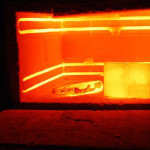what happens to steel pipe when heated with 100 c liquid
The electrical, magnetic and structural properties of metals tin can be changed through heat. As the applications of metal are varied, different environments prioritize different qualities. For example, in applied science applications, toughness is desired; in electrical applications, depression electrical resistivity is important.
There are a number of means of heating metal which are commonly used to transform these properties. The temperature to which the metal is heated and the rate of cooling are carefully controlled to achieve the desired outcome.
The Effect of Heat on Metal 
The most important ways that metals are transformed through oestrus:
- Electrical Resistance
- Thermal Expansion
- Structure
- Magnetism
Electrical Resistance
Electrical resistance is the mensurate of how strongly the metal impedes the passage of electrical current. As electrons pass through the metal, they scatter as they collide with the metallic structure. When the metal is heated, the electrons absorb more energy and move faster. This leads to more scattering, thus increasing the amount of resistance. Thermometers really apply the change in electric resistance in a slice of wire to measure temperature.
Thermal Expansion
Metal expands when heated. Length, surface area and volume volition increment with temperature. The scientific term for this is thermal expansion. The degree of thermal expansion varies with different types of metal. Thermal expansion occurs because heat increases the vibrations of the atoms in the metal. Bookkeeping for thermal expansion is essential when designing metallic structures. An everyday example would be the design of household pipes, which must accommodate expansion and contraction as the seasons change.
Structure
Metals are comprised of a symmetrical structure of atoms known as an allotrope. Heating the metal will displace atoms from their position and the displaced atoms form a new structure. This process is known every bit allotropic phase transformation. Allotropic phase transformation alters the hardness, strength and ductility of the metal. The nearly important allotropic phase transformation is undergone by iron. When fe is heated past 1,674 degrees Fahrenheit it is able to absorb more than carbon, which is an ingredient that will increase the hardness of any steel production. This desired effect is used in several types of Loftier Carbon (above 0.l carbon) steel – Case: Tool Steel
Magnetism
There are three metals with magnetic properties: iron, nickel and cobalt. They are known every bit ferromagnetic metals. Heating these metals will reduce their magnetization to the point where magnetism is completely eradicated. The temperature at which this occurs is known as the Curie temperature. For nickel, this temperature is 626 degrees Fahrenheit; for cobalt information technology is two,012 degrees Fahrenheit; and for Iron it is 1,418 degrees Fahrenheit.
Heat Handling
Estrus treatment is a process designed to alter the properties of the metal to meliorate suit its intended apply. The chief types of heat treatment are:
- Annealing
- Normalising
- Hardening
- Tempering
Annealing
Annealing is oft used to soften metals including atomic number 26, steel, copper, brass and silver. The procedure involves heating the metal to a specific temperature so allowing it to cool slowly at a controlled rate. Annealing alters the concrete and chemic properties of the metal to increase ductility and reduce hardness. This facilitates shaping, stamping or forming processes, and allows the metallic to exist cut more than easily. Annealing also enhances electrical conductivity.
Normalising
Normalising (commonly referred to as normalized) is applied to alloys to provide uniformity in grain size and composition. The metal is heated to a predefined temperature then cooled past air. The resulting metal is free of undesirable impurities and exhibits greater force and hardness. Normalising is ofttimes used to produce a harder and stronger steel, albeit one that is less ductile than that produced by annealing. Typically, the normalising process is performed on materials that will exist subjected to machining, because the process has improved this aspect.
Hardening
Hardening is applied to steel and other alloys to meliorate their mechanical properties. During hardening, the metallic is heated at a high temperature and this temperature is maintained until a proportion of carbon has been dissolved. Side by side the metal is quenched, which involves rapidly cooling it in oil or water. Hardening will produce an alloy which has loftier strength and wear resistance. However hardening will besides increase brittleness and is non suitable for engineering applications. When in that location is a need to have the surface of the component hard enough to resist wear and erosion, while maintaining ductility and toughness to withstand impact and shock loading — surface hardening would be used.
Tempering
Tempering is applied to steel where ductility is desired. Untempered steel is very hard just too breakable for nearly practical applications. Tempering is a depression temperature estrus handling process normally performed subsequently hardening (neutral hardening, double hardening, atmospheric carburising, carbonitriding, or induction hardening) in order to reach a desired hardness/toughness ratio. The process involves heating steel to a lower temperature to reduce some of the excess hardness. The metal is then allowed to cool in still air which results in a tougher and less breakable steel.
fergusonwhoul1960.blogspot.com
Source: https://www.metalsupermarkets.com/how-heating-metal-affects-its-properties/

0 Response to "what happens to steel pipe when heated with 100 c liquid"
Post a Comment